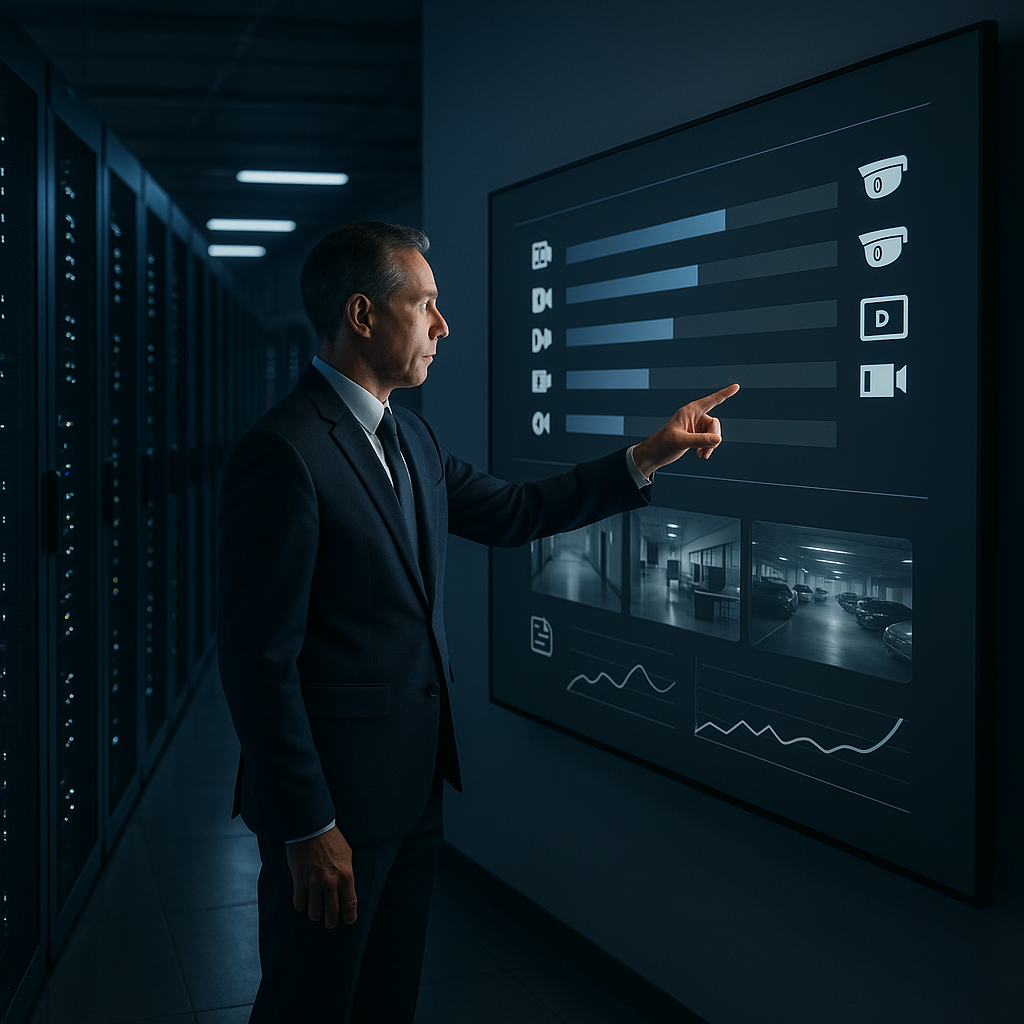1 min read
How to Choose the Best Enterprise Video Surveillance System
Enterprise security leaders face a critical challenge: selecting a video surveillance system that addresses current threats while adapting to future...
5 min read
 Tony Ridzyowski
:
Aug 15, 2025 4:14:22 PM
Tony Ridzyowski
:
Aug 15, 2025 4:14:22 PM
What happens if someone slips past your firewall physically and reaches your servers?
As cyber threats become more advanced, physical breaches remain one of the most underestimated risks to data center security. According to the 2024 Verizon Data Breach Investigations Report, 22% of breaches involved physical actions, and other studies indicate that roughly 60% of successful cyberattacks start with physical access or reconnaissance. These statistics highlight the importance of a layered video surveillance system as part of a comprehensive physical security strategy.
In the sections ahead, we break down the core components of an effective data center video surveillance plan, show how each layer strengthens physical security controls, and explain how modern tools like AI-powered video analytics, intrusion detection systems, thermal imaging, and cabinet-level monitoring work together to safeguard sensitive information, protect data centers, and meet compliance requirements.
Data centers are built to protect digital information, but their physical assets are just as valuable and just as vulnerable. Attackers don’t need sophisticated malware to cause damage when a misplaced badge or unmonitored entry point gives them direct access to the infrastructure.
The perimeter is the first layer of physical security. High-resolution CCTV cameras and AI video analytics monitor fences, gates, and approach routes to detect movement and spot anomalies. Thermal cameras boost visibility in low-light conditions, and motion-activated lighting with audio warnings reinforces deterrence while enabling real-time response. Learn more about perimeter security best practices in our enterprise surveillance guide.
Access control systems such as badge readers, keypads, and biometric scanners establish the first layer of verification, ensuring only authorized personnel can enter. Strategically placed surveillance cameras at all entry and exit points record and verify each interaction, while AI-powered facial recognition matches live video feeds with stored credentials to detect mismatches instantly. These measures reduce the likelihood of credential misuse, enhance intrusion detection, reinforce compliance with security standards, and provide a complete audit trail.
Server rooms require precision, traceability, and strict oversight. Smart cards, biometrics, and multi-factor authentication prevent unauthorized entry. Surveillance systems alert staff if doors remain open too long or if access occurs outside permitted hours. These layered controls reduce the risk of internal misuse, protect critical data, and maintain oversight in high-risk environments.
Each cabinet should be treated as its own security zone. Electronic locks track every access event, and PTZ cameras capture clear video of each interaction. When paired with biometric access control, these tools deliver strong protection against internal threats while supporting compliance with audit, accountability, and data protection requirements.
Environmental conditions such as overheating, humidity, or smoke are often early warning signs of significant problems. Surveillance systems equipped with thermal cameras, IoT sensors, and AI-powered monitoring detect these changes in real time. Flagging abnormal temperature spikes, detecting smoke particles, or identifying subtle signs of moisture allows data center teams to act quickly, maintaining uptime and securing assets.
Environmental monitoring systems track temperature, humidity, and air quality to spot conditions that signal equipment stress or failure. When values shift outside safe operating ranges, alerts go out immediately, giving your team time to act before the problem escalates. Early detection supports security best practices, protects critical infrastructure, and minimizes downtime.
Video surveillance is only as dependable as its storage. Power failures, hardware issues, or natural disasters can wipe out critical footage if there’s no backup plan. To avoid this, data centers should use redundant storage by saving video locally and off-site to reduce the chance of loss. Some systems support automatic failover, encryption, and advanced security controls to ensure footage remains available for audits and investigations.
Alarms and motion sensors enable security teams to respond in real-time. These systems detect movement or tampering at entry points and trigger immediate responses through video surveillance, lighting, and audible alerts. When integrated with cameras, motion-based detection not only confirms an intrusion but also provides visual evidence to guide the response.
Even with smart surveillance systems in place, trained personnel remain essential. Security guards provide oversight that technology alone cannot match, such as responding to real-world cues, verifying threats, and managing incidents. Guards can monitor live video feeds, coordinate with first responders, and ensure systems are functioning as expected, creating a stronger overall security posture.
Network audio systems add a vocal layer of deterrence. When a potential threat is detected, pre-recorded or live voice warnings can be broadcast to deter intruders or instruct staff. For on-site personnel, body cameras provide both real-time visibility and a documented record of all interactions during maintenance, audits, or emergencies. This measure increases accountability and transparency, ensuring all activities are documented and verifiable for security audits.
AI-driven surveillance systems go beyond passive monitoring. These platforms learn typical behavior patterns and flag anomalies, whether it's someone loitering near restricted areas, accessing the facility at odd hours, or moving in unusual ways. They can trigger alerts, direct PTZ cameras, and help operators manage multiple data centers from a single interface. With fewer false alarms and faster decision-making, AI improves both security and operational efficiency. See our enterprise video surveillance services for integrated monitoring solutions.
Securing a data center means having complete control over every access point, continuous monitoring of every camera feed, and uncompromising protection for each server rack. Physical security is a fundamental pillar of compliance. It is central to risk management, operational continuity, and data protection. The right surveillance strategy can minimize downtime, deter insider threats, strengthen compliance readiness, and protect your infrastructure against both external and internal risks.
With more than 25 years in the industry, over 30 technical certifications, and a history of more than 1,000 successful projects, Turn-key Technologies (TTI) has earned a reputation for delivering reliable, real-world solutions. Clients across sectors trust TTI for precision, dependability, and long-term value.
As one client from the Times Union Center noted: TTI has been a true partner in delivering well-designed, budget-conscious solutions that meet project needs. The team applies that same expertise to designing, installing, and supporting surveillance systems that provide real-time visibility, layered access control, intrusion detection, and dependable performance for mission-critical facilities.
Explore real-world results and see how TTI secures critical environments in our case studies. When you’re ready to assess your facility, schedule a security audit with our team.

Tony Ridzyowski leads the Inside Sales Team at Turn-key Technologies, where he also supports marketing, partner relations, training, event planning, and CRM initiatives. With 20+ years of experience and multiple certifications in networking, wireless, and cybersecurity, Tony brings deep expertise to every project. Since joining TTI in 2014, he has earned recognition as a top producer and Presidents Club member. His career also includes roles in the network cabling industry and with Fortune 500 companies such as Wells Fargo and Countrywide Home Loans.

1 min read
Enterprise security leaders face a critical challenge: selecting a video surveillance system that addresses current threats while adapting to future...
%20(2).png)
Physical security is essential for safeguarding people, property, and information from threats like unauthorized access, theft, vandalism, and...

Video surveillance is a cornerstone of modern enterprise security, but without clear retention policies, organizations risk overspending on storage,...